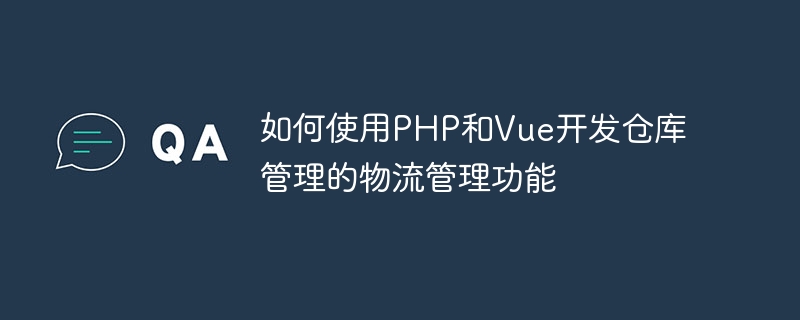
如何使用PHP和Vue开发仓库管理的物流管理功能
随着电子商务的快速发展,仓库管理的物流管理功能变得越来越重要。在这篇文章中,我将介绍如何使用PHP和Vue来开发一个简单而实用的仓库管理系统,并提供具体的代码示例。
在开始开发之前,我们需要准备一些开发环境。首先,确保你的电脑上已经安装了PHP和Vue的开发环境。你可以通过下载和安装XAMPP、WAMP或MAMP来搭建本地的PHP开发环境。同时,你也需要安装Node.js来支持Vue的开发。你可以通过在命令行中运行以下命令来检查是否已经安装了Node.js:
node -v
仓库管理系统需要一个数据库来存储物流管理的相关数据。在这个例子中,我们将需要创建一个名为"warehouse"的数据库,并创建以下两个表来存储数据:
立即学习“PHP免费学习笔记(深入)”;
物品表(items):用于存储所有入库的物品信息。
CREATE TABLE items ( id INT(11) AUTO_INCREMENT PRIMARY KEY, name VARCHAR(255), quantity INT(11), created_at TIMESTAMP DEFAULT CURRENT_TIMESTAMP );
物流表(shipments):用于存储所有物流信息,包括物流公司、寄件人、收件人等。
CREATE TABLE shipments ( id INT(11) AUTO_INCREMENT PRIMARY KEY, item_id INT(11), company VARCHAR(255), sender VARCHAR(255), receiver VARCHAR(255), created_at TIMESTAMP DEFAULT CURRENT_TIMESTAMP, FOREIGN KEY (item_id) REFERENCES items(id) );
接下来,我们将通过PHP来搭建后端的API接口。
首先,创建一个名为"api"的文件夹,并在其中创建一个名为"index.php"的文件。在"index.php"中,我们将创建以下几个API接口:
获取所有物品信息:
<?php
header("Content-Type: application/json");
require_once 'config.php';
$query = "SELECT * FROM items";
$result = mysqli_query($conn, $query);
$items = [];
while ($row = mysqli_fetch_assoc($result)) {
$items[] = $row;
}
echo json_encode($items);创建新物品:
<?php
header('Content-Type: application/json');
require_once 'config.php';
$name = $_POST['name'];
$quantity = $_POST['quantity'];
$query = "INSERT INTO items (name, quantity) VALUES ('$name', $quantity)";
$result = mysqli_query($conn, $query);
$response = [];
if ($result) {
$response['message'] = 'Item created successfully';
} else {
$response['message'] = 'Failed to create item';
}
echo json_encode($response);获取所有物流信息:
<?php
header("Content-Type: application/json");
require_once 'config.php';
$query = "SELECT shipments.id, items.name, shipments.company, shipments.sender, shipments.receiver, shipments.created_at
FROM shipments
INNER JOIN items
ON shipments.item_id = items.id";
$result = mysqli_query($conn, $query);
$shipments = [];
while ($row = mysqli_fetch_assoc($result)) {
$shipments[] = $row;
}
echo json_encode($shipments);创建新物流信息:
<?php
header('Content-Type: application/json');
require_once 'config.php';
$item_id = $_POST['item_id'];
$company = $_POST['company'];
$sender = $_POST['sender'];
$receiver = $_POST['receiver'];
$query = "INSERT INTO shipments (item_id, company, sender, receiver) VALUES ($item_id, '$company', '$sender', '$receiver')";
$result = mysqli_query($conn, $query);
$response = [];
if ($result) {
$response['message'] = 'Shipment created successfully';
} else {
$response['message'] = 'Failed to create shipment';
}
echo json_encode($response);在"api"文件夹中还需要创建一个名为"config.php"的文件,该文件用来配置数据库连接信息:
<?php
$conn = mysqli_connect('localhost', 'root', '', 'warehouse');
if (!$conn) {
die("Connection failed: " . mysqli_connect_error());
}现在,我们将使用Vue来开发前端界面。
在项目的根目录下创建一个名为"frontend"的文件夹,并通过命令行进入该文件夹。
首先,安装Vue CLI。在命令行中运行以下命令:
npm install -g @vue/cli
创建一个新的Vue项目。在命令行中运行以下命令,并根据提示进行配置:
vue create warehouse-management
进入新创建的Vue项目的目录。在命令行中运行以下命令:
cd warehouse-management
安装所需的依赖。在命令行中运行以下命令:
npm install
在"src"文件夹中创建一个名为"components"的文件夹,并在其中创建以下几个组件:
Item列表组件(ItemList.vue):
<template>
<div>
<h2>物品列表</h2>
<table>
<thead>
<tr>
<th>物品名称</th>
<th>数量</th>
<th>操作</th>
</tr>
</thead>
<tbody>
<tr v-for="item in items" :key="item.id">
<td>{{ item.name }}</td>
<td>{{ item.quantity }}</td>
<td>
<button @click="deleteItem(item.id)">删除</button>
</td>
</tr>
</tbody>
</table>
<h3>添加新物品</h3>
<input type="text" v-model="newItemName" placeholder="物品名称">
<input type="number" v-model="newItemQuantity" placeholder="数量">
<button @click="createItem">添加</button>
</div>
</template>
<script>
export default {
data() {
return {
items: [],
newItemName: '',
newItemQuantity: 0
};
},
mounted() {
this.getItems();
},
methods: {
getItems() {
axios.get('/api/get_items.php').then(response => {
this.items = response.data;
});
},
createItem() {
axios.post('/api/create_item.php', {
name: this.newItemName,
quantity: this.newItemQuantity
}).then(response => {
this.getItems();
this.newItemName = '';
this.newItemQuantity = 0;
});
},
deleteItem(id) {
axios.post('/api/delete_item.php', {
id: id
}).then(response => {
this.getItems();
});
}
}
};
</script>Shipment列表组件(ShipmentList.vue):
<template>
<div>
<h2>物流列表</h2>
<table>
<thead>
<tr>
<th>物品名称</th>
<th>物流公司</th>
<th>寄件人</th>
<th>收件人</th>
<th>创建时间</th>
</tr>
</thead>
<tbody>
<tr v-for="shipment in shipments" :key="shipment.id">
<td>{{ shipment.name }}</td>
<td>{{ shipment.company }}</td>
<td>{{ shipment.sender }}</td>
<td>{{ shipment.receiver }}</td>
<td>{{ shipment.created_at }}</td>
</tr>
</tbody>
</table>
<h3>添加新物流</h3>
<select v-model="selectedItem">
<option v-for="item in items" :value="item.id">{{ item.name }}</option>
</select>
<input type="text" v-model="newShipmentCompany" placeholder="物流公司">
<input type="text" v-model="newShipmentSender" placeholder="寄件人">
<input type="text" v-model="newShipmentReceiver" placeholder="收件人">
<button @click="createShipment">添加</button>
</div>
</template>
<script>
export default {
data() {
return {
items: [],
selectedItem: '',
shipments: [],
newShipmentCompany: '',
newShipmentSender: '',
newShipmentReceiver: ''
};
},
mounted() {
this.getItems();
this.getShipments();
},
methods: {
getItems() {
axios.get('/api/get_items.php').then(response => {
this.items = response.data;
});
},
getShipments() {
axios.get('/api/get_shipments.php').then(response => {
this.shipments = response.data;
});
},
createShipment() {
axios.post('/api/create_shipment.php', {
item_id: this.selectedItem,
company: this.newShipmentCompany,
sender: this.newShipmentSender,
receiver: this.newShipmentReceiver
}).then(response => {
this.getShipments();
this.newShipmentCompany = '';
this.newShipmentSender = '';
this.newShipmentReceiver = '';
});
}
}
};
</script>在"src"文件夹中打开"App.vue"文件,将以下代码添加到文件的相应位置:
<template>
<div id="app">
<item-list></item-list>
<shipment-list></shipment-list>
</div>
</template>
<script>
import ItemList from './components/ItemList.vue';
import ShipmentList from './components/ShipmentList.vue';
export default {
components: {
ItemList,
ShipmentList
}
};
</script>至此,我们已经完成了使用PHP和Vue开发仓库管理的物流管理功能的示例代码。你可以通过运行"npm run serve"命令来开启前端开发服务器,在浏览器中访问"http://localhost:8080"来查看项目效果。同时,你也需要通过运行PHP开发服务器来让API接口生效。
希望以上示例能够帮助你了解如何使用PHP和Vue来开发仓库管理的物流管理功能。当然,这只是一个简单的示例,你可以根据实际需求进行功能的扩展和优化。祝你开发顺利!
以上就是如何使用PHP和Vue开发仓库管理的物流管理功能的详细内容,更多请关注php中文网其它相关文章!

PHP怎么学习?PHP怎么入门?PHP在哪学?PHP怎么学才快?不用担心,这里为大家提供了PHP速学教程(入门到精通),有需要的小伙伴保存下载就能学习啦!

Copyright 2014-2025 https://www.php.cn/ All Rights Reserved | php.cn | 湘ICP备2023035733号